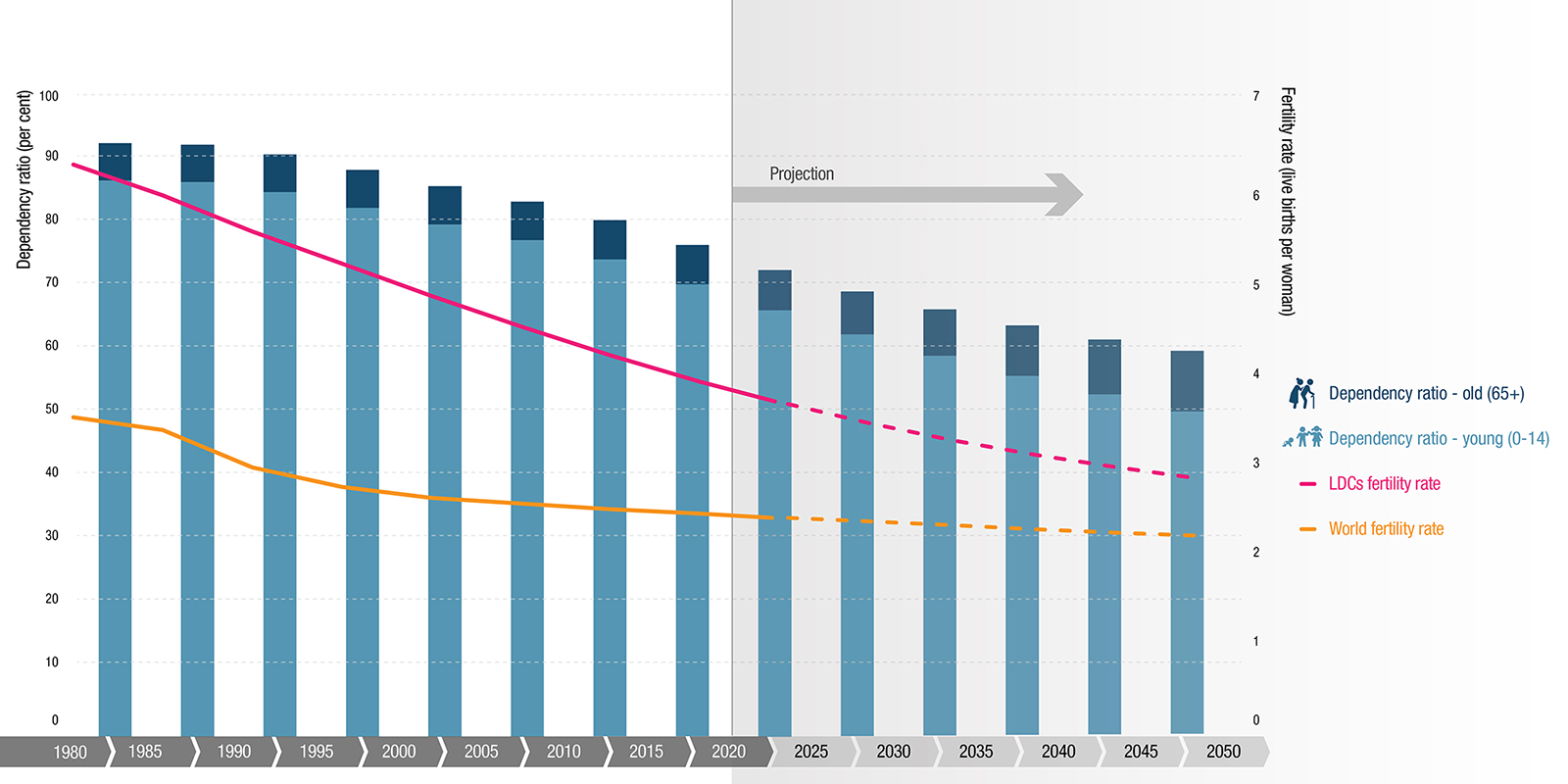For most of the world's most vulnerable countries, the promise of younger generations driving development and contributing to higher living standards will depend upon the right socioeconomic policy mix.

Date: 1 September 2021
Source: UNCTAD calculations based on data from the Population Division of the UN Department of Economic and Social Affairs (2019).
Note: The graph is based on the medium variant of the UN’s population projections. Data from 2020 onwards are projections. The young-age dependency ratio is defined as the number of young people (under age 15) per hundred people of working age (15-64 years). The old-age dependency ratio is defined as the number of older people (aged 65 years or more) per hundred people of working age.
Despite the steady decline in the fertility rate in least developed countries (LDCs) since the 1980s, their populations remain among the fastest growing.
The above chart shows that between 2015 and 2020, the average fertility rate in LDCs was four children per woman, compared with a world average of 2.5. As a result of an increase in life expectancy and in the absence of a corresponding decrease in fertility rate, LDCs’ average population growth rate was estimated at 2.3%, about twice the world average (1.1 %).
As LDCs lack rapid improvements in productivity levels and employment creation, such fast population growth poses rising development challenges, with an increasing pressure on natural resources, making the realization of a demographic dividend – economic growth spurred by demographic changes – far-fetched.
These challenges are amplified by the COVID-19 pandemic, with long-term implications on the prospects for LDCs to harness the demographic dividend.
Demographic transition
Specifically, LDCs remain at the early stages of a demographic transition (moving from a high-fertility, high-mortality regime to a low-fertility, low-mortality regime) progressing at a relatively slow pace compared to other developing countries, as well as advanced economies.
This is unambiguous when the median age of the LDC population (20.3 in 2020) and the sluggish decline of dependency ratios are considered. The data presented show that LDC dependency ratios fell from 91.7% of the working-age population in 1980-1985 to 75.7% in 2015-2020, with forecasts for 2045-2050 reaching 58.8%.
Meanwhile, LDCs will continue to experience strong growth in the working-age population (15-64), which is expected to double between 2020 and 2050, rising from 610 million to 1.2 billion.
In principle, a declining dependency ratio, together with an expansion of the working-age population, can create a window of opportunity for LDCs to realize large and sustained demographic dividends. But this is not automatic.
Right socioeconomic policy mix vital
For most LDCs, the promise of younger generations driving development and contributing to higher living standards will depend upon the right socioeconomic policy mix.
A lower dependency ratio presents an opportunity for LDCs to increase investments in human capital by improving access to education and health, and enhancing gender equality and prospects for productive employment.
All of this, however, hinges on LDCs’ ability to generate sufficient productive employment to absorb new entrants in the labour market over the medium term.
To prevent this situation from entrenching poverty, underemployment and vulnerable employment, productive capacity development needs to gain momentum, contributing to structural change and economic diversification.
Importantly, this goes well beyond a mere emphasis on self-employment and survivalist types of entrepreneurship. It rather warrants the strengthening of the whole entrepreneurial ecosystem, notably in terms of small and medium-sized enterprises and innovative types of firms.
The issue of how to respond to potential employment challenges and realize the demographic dividend despite the lingering impacts of COVID-19 and future shocks should be high on the agenda of policymakers.
Download:
- The Least Developed Countries Report 2020: Productive capacities for the new decade
- The Least Developed Countries Report 2018: Entrepreneurship for structural transformation: Beyond business as usual
- UNCTAD Productive Capacities Index: : Methodological Approach and Results


